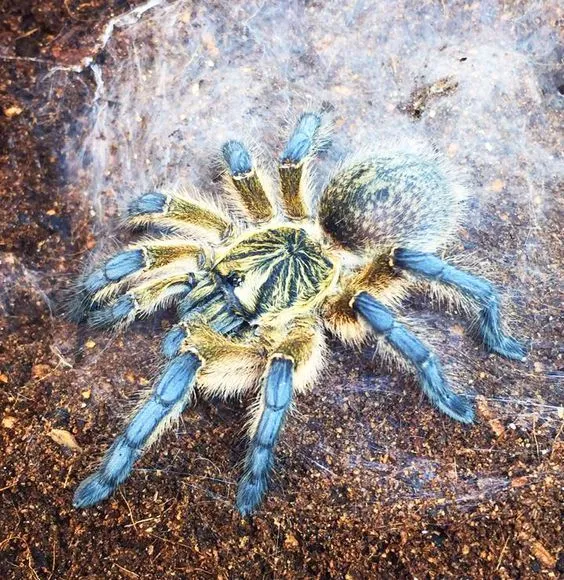Tarantula Spiders How Dangerous Are They?
Tarantulas, with their large, hairy bodies and imposing size, often evoke fear. But how dangerous are these creatures really? While they certainly look intimidating, the reality of tarantula danger is more nuanced than many people believe. This article delves into the various aspects of tarantula danger, exploring their venom, bite symptoms, attack behaviors, and how to stay safe around them. Understanding these aspects is crucial for anyone who encounters these fascinating arachnids, whether in the wild or as pets. We’ll uncover some surprising facts and dispel common myths, providing a clear picture of the risks and how to minimize them.
Tarantula Venom Is It Dangerous?
The venom of a tarantula is a key factor in assessing its danger. While all tarantulas possess venom, the potency varies greatly among species. It’s important to note that tarantula venom is not typically life-threatening to humans. Most bites result in effects similar to a bee sting, with localized pain, redness, and swelling. However, this doesn’t mean that tarantula bites are completely harmless. The severity of the reaction can depend on several factors, including the individual’s sensitivity to the venom and the species of tarantula involved. It’s always wise to treat a tarantula bite with respect, as there is a possibility of allergic reactions and secondary infections.
The Toxicity Level of Tarantula Venom

Compared to the venom of other venomous creatures, such as snakes or scorpions, tarantula venom is relatively mild. Its primary purpose is to subdue prey, such as insects, small rodents, and birds, not to inflict serious harm on larger animals like humans. The venom is a complex mixture of proteins, enzymes, and other compounds that act on the nervous systems of their prey. While the exact composition varies among species, the general effects are similar. The focus of this venom isn’t designed to do major damage to humans, but can still cause some discomfort.
Tarantula Bite Symptoms
The symptoms of a tarantula bite can vary, but most are localized and not life-threatening. Understanding these symptoms can help you assess the severity of the bite and take appropriate action. The immediate reaction to a bite can range from mild to moderate discomfort, and it’s essential to monitor the affected area for any worsening symptoms. The majority of bites result in localized effects, while systemic reactions are far less common. It’s always a good idea to seek medical advice if you experience severe symptoms or if the bite is from a species you’re unfamiliar with, just to be on the safe side.
Local Reaction Symptoms
The most common symptoms of a tarantula bite are localized to the bite site. These often include immediate pain, which can vary from a sharp sting to a dull ache. Redness and swelling around the bite area are also typical, as the body responds to the venom. In some cases, there may be itching or a burning sensation. These local reactions usually subside within a few hours to a day or two. Applying a cold compress and taking an over-the-counter pain reliever can help manage the symptoms. It’s important to keep the bite area clean to prevent infection, and watch for signs of worsening symptoms, like increased swelling or pus.
Systemic Reaction Symptoms

Systemic reactions, which affect the entire body, are rare after a tarantula bite. However, in sensitive individuals or in cases of multiple bites, more severe symptoms can occur. These may include nausea, dizziness, muscle cramps, and in very rare instances, difficulty breathing. If you experience any of these systemic symptoms, it is crucial to seek immediate medical attention. Allergic reactions, such as hives or swelling of the face or throat, can also occur and should be treated as a medical emergency. Quick medical intervention can make a difference in managing severe reactions and preventing complications.
Do Tarantulas Attack?
Despite their intimidating appearance, tarantulas are generally not aggressive creatures. They are more likely to flee than to attack, and their first line of defense is usually to escape. Bites typically occur only when a tarantula feels threatened, such as when it is cornered, mishandled, or feels that its safety is at risk. Understanding their defensive behaviors is important for preventing bites and ensuring safe interactions. The key is to avoid actions that may be perceived as a threat by the tarantula, allowing them space and observing them from a safe distance will decrease the chances of a bite.
Defensive Behaviors of Tarantulas
When threatened, tarantulas exhibit a range of defensive behaviors. One common defense is the flicking of urticating hairs from their abdomen. These hairs are barbed and can cause intense itching and irritation if they come into contact with skin or eyes. Some species also make a hissing sound by rubbing their legs together. A tarantula may also raise its front legs in a threatening posture to deter potential predators. The final resort is biting, and this happens only when other defenses fail. It’s crucial to respect these behaviors and give tarantulas space when handling or observing them. Being aware of these defense mechanisms is critical to avoid disturbing them and, in turn, reduce the chances of getting bitten.
How Likely Are You to Be Bitten by a Tarantula?

The likelihood of being bitten by a tarantula is relatively low, especially if you avoid handling them or provoking them. Most tarantula bites occur in situations where the spider feels threatened or is accidentally handled. If you live in an area where tarantulas are native or keep them as pets, it’s important to understand the risks and take appropriate precautions. Avoiding direct contact, providing a safe environment, and respecting the spider’s space can significantly reduce the chances of a bite. Careful handling and a good understanding of tarantula behavior are essential for minimizing any potential risks.
Geographical Distribution and Species
Tarantulas are found in various regions around the world, and the danger level can vary depending on the species. Knowing which species are native to your area can help you assess the potential risks. Some species have more potent venom or more aggressive behaviors than others. The habitat and local conditions also play a role in how often you might encounter tarantulas. Learning about the different species, their characteristics, and where they live is a crucial part of tarantula safety.
North American Tarantula Species
In North America, several tarantula species are relatively common. These spiders are generally not considered highly dangerous to humans, and their bites are usually mild. Common species include the Texas Brown Tarantula and the Arizona Blonde Tarantula. Their venom is not particularly potent, and bites typically cause localized pain, redness, and swelling. They are more likely to run and hide than to attack, and the risk of being bitten is low unless they feel threatened. Educating yourself about the local species can make your interactions much safer and less intimidating.
South American Tarantula Species

South America is home to a diverse range of tarantula species, including some of the largest in the world. Some species from this region are known for their potent venom and aggressive behavior. The Goliath Birdeater, for example, is one of the biggest tarantulas, and while its venom isn’t lethal to humans, its bite can be painful and cause significant discomfort. Other species may have similar characteristics, and it’s vital to approach these spiders with extra caution. The presence of such species underscores the importance of knowing what tarantulas are around you and treating them with the utmost respect.
Asian and Australian Tarantula Species
Asia and Australia are home to various tarantula species, some of which are more prone to defensive behavior and more potent venom. While most species are not deadly, their bites can be painful and may cause more significant local reactions. Some Australian species are known for their defensive postures and can inflict painful bites. It is essential to understand the characteristics of the specific species in these regions, as some may pose a higher risk than those found in North America. Taking extra precautions and understanding their behavior can help to avoid any problems.
Tarantula Bite Treatment
If you are bitten by a tarantula, it’s important to take immediate action to minimize the impact of the bite. This involves first aid measures to reduce pain and prevent infection, as well as knowing when to seek professional medical attention. Being prepared with the right information can make a big difference in managing the situation effectively. It’s essential to remember that the severity of the bite can vary, so acting quickly and calmly is crucial.
Immediate First Aid

The first steps in treating a tarantula bite are similar to those for other insect bites or stings. First, wash the bite area thoroughly with soap and water to prevent infection. Apply a cold compress to reduce pain and swelling. If you have any, you can take an over-the-counter pain reliever, such as ibuprofen or acetaminophen, to help with pain. It’s also a good idea to elevate the bitten limb to reduce swelling. Watch for any signs of a severe reaction. The goal is to keep the wound clean, alleviate pain, and monitor the symptoms to see if they worsen.
When to Seek Medical Attention
While most tarantula bites don’t require medical intervention, there are situations where it is necessary to seek professional help. If you experience any severe symptoms, such as difficulty breathing, swelling of the face or throat, or severe muscle cramps, seek immediate medical attention. If you are unsure of the species of the tarantula, it is also wise to get checked out by a doctor. Medical professionals can assess the severity of the bite, provide appropriate treatment, and monitor for any complications. Early treatment can help prevent secondary infections or complications. Getting medical advice will ensure you receive proper care and can alleviate some of your concerns.
Preventing Tarantula Bites
The best way to avoid the dangers of tarantulas is to prevent bites in the first place. Understanding the spiders’ behaviors, respecting their space, and handling them safely are key to minimizing the risk. Being proactive and taking precautions can allow you to enjoy them without putting yourself at risk. A little knowledge and some common-sense practices can ensure that you stay safe when interacting with these creatures. The fewer interactions you have with tarantulas, the lower your risk of being bitten.
Handling Tarantulas Safely

If you choose to handle a tarantula, it’s important to do so safely. Never handle a tarantula unless you are experienced and knowledgeable about the species. Always handle them over a soft surface, such as a bed or a thick carpet, to minimize the risk of injury if the spider falls. Avoid sudden movements, and never try to grab or restrain the spider. Use a soft brush to gently encourage the tarantula to move if needed. Wash your hands thoroughly after handling to remove any urticating hairs or potential irritants. Careful handling and a calm approach can significantly reduce the chances of provoking a bite.
Habitat Safety
When exploring areas where tarantulas may be present, it’s important to take precautions to avoid accidental encounters. Wear long sleeves and pants, especially if you are working in areas with dense vegetation, where tarantulas might hide. Avoid reaching into crevices or under rocks without first checking for potential hazards. When hiking or camping, be mindful of where you are sitting or placing your hands and feet. If you keep tarantulas as pets, make sure their enclosure is secure and escape-proof. By being vigilant and understanding where tarantulas might be, you can minimize the risk of encountering them and reduce the chances of being bitten.
